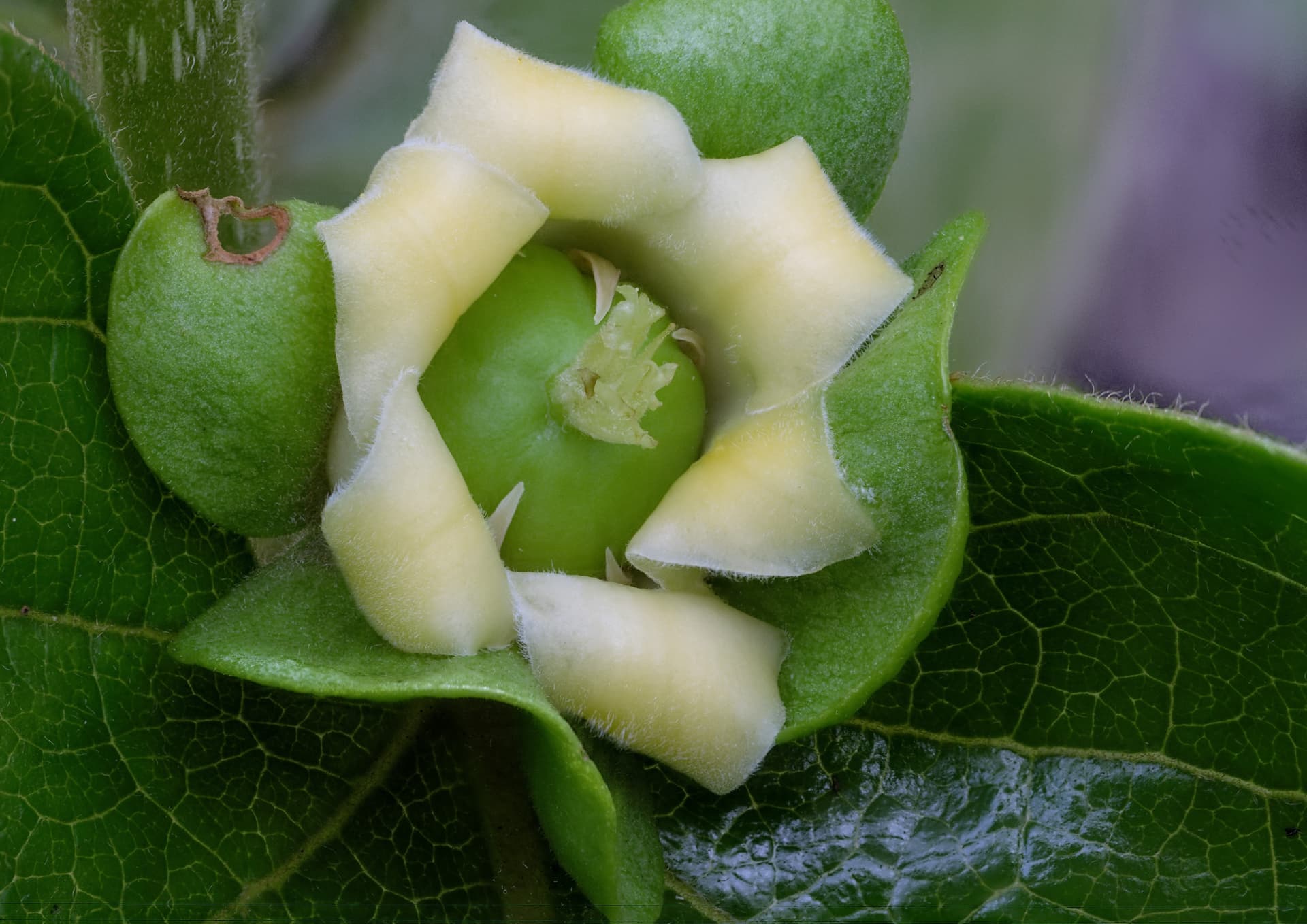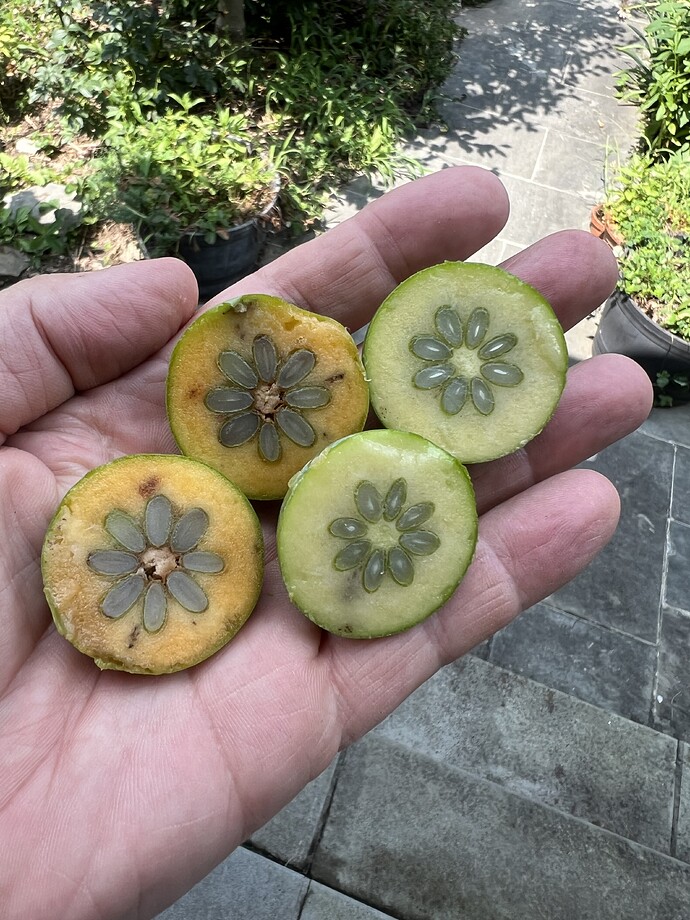Thanks. Your experience is valuable. Hard to resist not trying to do something with the root sprouts. Every 3-4 feet there is a clump of at least a dozen that are now 4-5 tall. But too close to have mature trees that close.
Nice! It looks like you are also in MI. I lost my potted cardinal persimmon over the winter in my garage; stored the same way that I keep my figs/jujube/pom. I’m tempted to try again with this variety.
Looks like you’re in SE MI too. Send me a message if you are interested in a trade this winter, I could likely spare a scion off the tree, even though its small.
Do squirrels sometimes take immature kaki persimmons?
The other day I saw a squirrel running up a tree with an immature beaked hazelnut in the husk, or so I thought. I was surprised that they take them green, but was also reminded that I usually overestimate how long it takes the hazelnuts to mature and they are gone when i go to check.
But the next day I saw a (that?) squirrel rustling around in my Coffeecake persimmon tree that happens to be the closest tree to the one that was run up the day before.
It occurred to me that from my vantage a green hazelnut looks about the same as a very immature kaki ![]()
I don’t have kaki, but do have the hazels, persimmons and too many squirrels. The squirrels usually harvest the nuts before I ever would. As far as the persimmons, I noticed the first time that they produced that the squirrels taste tested them, but soon left them alone and haven’t bothered them since.
If your Coffee Cake persimmon is pollinated and therefore non-astringent then they certainly could be stealing them. They steal my neighbor’s IKKJ fruit most years well before they are ripe. It is one of the reasons I don’t have any non-astringent types in my yard, although I do have one PVNA (Zenji Maru) out close to the curb that may get hit.
In our drought last year, I did have some steal a few American persimmons, but they were usually found within a few feet of the tree with a bite mark or 2 in it before the squirrel abandoned the effort.
Very interesting. Do others see the same problem- squirrels take non-astringents but not astringents? At my suggestion a friend is about to order either Wase Fuyu or Maekawa Jiro, both non-astringent for her front yard adjacent to woodland. Maybe I should switch that to Giboshi or Giombo…
This was common knowledge I thought, astringency works for animals too. It WOULD be news if this wasn’t always the case
I manage squirrels here so would not see this play out. I still have some squirrels that go after apples, pears but never persimmons of either variety.
@hambone I would say that the persimmons aren’t their first choice. Mine take peaches and Asian pears first, then Euro pears and apples and then seem to get around to my neighbors IKKJ fruit. So if you don’t have a lot of squirrels because they are well “managed” and you have fruit they prefer, they probably don’t get around to them.
I think how aggressively they come for the fruit also depends on whether there are large trees nearby that they can escape to. I’ve noticed I mostly see the squirrels coming out of my oaks and the neighbor’s big maple. But last year during the drought they came from everywhere … I’d literally see them coming down the street along the sidewalk and up my front walkway. So if your friend is planting the trees far away from larger trees with squirrels they might be okay.
My Giboshi, which is overloaded and I hadn’t thinned yet, is taking care of thinning on its own it seems. It is probably dropping a third of the fruit. Always curious, I cut some open and it certainly isn’t because of any lack of pollination. Look at those chunky seeds!
I am afraid the fruit will be small this year since I’ve left so many on for so long. Something to remember for next year…
Well, another disappointment with my grafts. We had a huge very hard Noah’s Ark type of rain on Monday for about 45 minutes that poured down 2 inches of rain in that short time. Two of my DEC Goliath grafts that were lush, tall and beautiful with thick stems and large leaves were literally just torn off at the graft site and hanging from the tape around the stump they were grafted to. Can’t even blame the deer this time. No leaves were eaten, and I am pretty sure the sheer weight of the water and the little bit of wind just tore them off.
Oddly enough, at least 5 grafted stumps of persimmon, mostly Dollywood and Rosseyanka did not succumb to the rain, and they were even taller, lusher and thicker than the DEC Goliath grafts. I guess I will just let the wild persimmon sprouts take over to keep those trees alive, and try again next spring. I guess it might be helpful to stake those top-heavy grafts, and also it was probably past time to head the grafts to induce side-branching above deer level. That might have reduced the weight and kept the graft from snapping. Live and learn.
Unrelated to persimmons, but the deer must have stood on their hind legs and jumped up into the old Russian alba stump to which I grafted Varaha mulberry and pulled the graft loose. Pretty sure it was deer because the leaves were eaten off the branch. This was my ONLY mulberry graft that took and it was growing nicely. Deer tore off my William’s Pride graft to Liberty Apple also.
So between the persimmons, apple and mulberry, I just sat among the trees and shed a few tears. Grafting is not for the faint of heart!
Sandra
Your experience isn’t unusual. I’ve lost a few beautiful, lush grafts to a gust of wind. The lesson I learned is that even though it takes extra time and work, we have to take steps to protect the graft in its first year or two. That involves both staking the graft (rootstock and scion) so that its mobility is limited AND pruning the lush growth to provide less surface for the wind to play with.
I’m finding that I have to do the same with my mulberries, even as grown trees, because the wood is too brittle to stand up to a typical gale.
@jrd51 Yes, you are right. I definitely need to take that extra step and stake my grafts. I put a lot of effort into cutting the tops of those trees out and doing the grafts, so a little more effort to place a stake will be worth it now that I have seen how easily wind and water can snap a graft. Appreciate the encouragement and information to improve my grafting success!
Sandra
Deer ripped up a bunch of my grafts also this year. Had to go around to all the others and supply some protection before I lost them all. I grafted five foot or higher and they still managed to jump up and rip them down. Luckily I had some left over scion to re-graft a few of them.
In my experience, this is not true. Granted, I’m only into the low hundreds of grafts at this point in my career, but the grafts that fail seem to be the ones that grow weakly. They’re less likely to make it through the winter as well. My very best grafts are always on rootstocks that have been in pots for a year and received fertilization in the fall, followed by mid-season fertilization.
Grafts that grow vigorously put more diameter down as well, which means a stronger graft union at the end of the season. You do need to stake your grafts, though, to reduce risk of bird and wind damage.
The other thing to note is I use organic, slow-release fertilizers that are pretty mild compared to something like a certain miraculous growth product.
Squirrels want to swipe most of the kinds of fruits I grow, but I’ve never seen them taking a persimmon. Only deer go after them and I’m working to get the trees above the deer.
… I am using a new squirrel control method this year, I’ll make a post about it once it’s been thoroughly tested but so far it’s rocking it. I’m just running a couple wraps of that super cheap 1"x1" square plastic bird netting around the trunk as a baffle. They hate the stuff, everything gets caught in it. I came up with the idea based on how it kept getting stuck to me, branches, everything.
You don’t have issues with coons, possum, or ground hogs? I’m dying to try that myself, but I question if it would work on larger thieves. I’ve got tons of that cheap netting. My new use for it has been to wrap new growth on grafts to keep deer from destroying them. They hate that stuff also. On my cages I insert sticks going around then wrap it with the netting to extend the height.
Yes I have all of those guys… everybody loves my fruit ![]()
So far no predation from anything but we will see.
I got the idea of using this stuff for things besides birds from how you were using it on deer, I now also wrap all grafts and new plants with this stuff outside the regular deer fencing to keep them off. It works like a charm on the deer.

